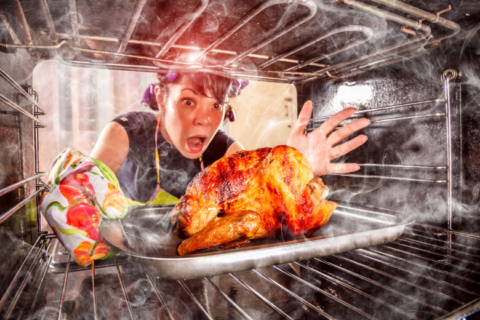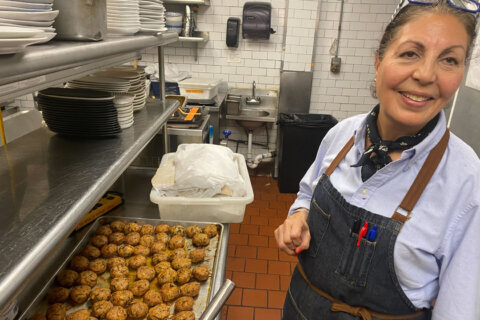If you have diabetes, then Thanksgiving may feel like a race to manage what you eat without spiking your blood sugar. However, there are ways to enjoy the bounty of the holiday without wreaking havoc on your body.
“Patients with diabetes are faced with challenges daily, and events such as Thanksgiving are no exception,” says Mark A. Smith, Jr., a certified diabetes care and education specialist in Birmingham, Alabama. The main challenge? Managing your blood sugar during a holiday that’s traditionally associated with high-carb foods.
[Read: 8 Strategies for Maintaining a Healthy Relationship With Food.]
How to Navigate Thanksgiving With Diabetes
Here are 10 tips to enjoy your Thanksgiving while keeping your diabetes under control.
— Go into the holiday with healthy habits.
— Don’t skip breakfast or lunch the day of Thanksgiving.
— Think about lower-carb, lower-sugar alternatives.
— Plan your plate.
— Manage portion control.
— Don’t forget about the beverages.
— Eat dessert mindfully.
— Don’t forget to keep moving.
— Check your blood sugar on Thanksgiving regularly.
— Focus on the reason for Thanksgiving.
Go into the holiday with healthy habits.
Your game plan should actually start before Turkey Day. First, make sure that you are practicing healthy habits, such as getting physical activity, staying hydrated and eating at regularly scheduled times, says Grace Derocha, a registered dietitian and Detroit-based national spokesperson for The Academy of Nutrition and Dietetics. These habits will help you start the holiday with the right frame of mind.
Don’t skip breakfast or lunch the day of Thanksgiving.
Marissa Meshulam, a registered dietitian nutritionist and founder of MPM Nutrition in New York City, stresses the importance of eating before the actual Thanksgiving meal. You may have a natural inclination to want to skip breakfast or other meals prior to the Thanksgiving feast to save on calories and carbs. However, this could affect your blood sugar and make you want to eat more than usual during Thanksgiving dinner.
Aim for a protein-filled breakfast to help your blood sugar stay stable throughout the day. Meshulam’s meal ideas: a vegetable omelet or Greek yogurt with berries, nuts and cinnamon on top.
Think about lower-carb, lower-sugar alternatives .
Some alternative dishes to consider include:
— Cauliflower stuffing.
— Crustless pumpkin pie.
— Low-carb cornbread or pumpkin muffins.
— Mashed potatoes with half-mashed cauliflower.
— Sugar-free cheesecake.
— Sweet potato casserole that also includes carrots and/or doesn’t have marshmallows on top.
— Vegetarian mushroom gravy.
Recipes for these dishes, and other low-carb food swaps, are easily found online. If you’re preparing the Thanksgiving feast, consider your menu in advance to include a mix of lean protein and vegetable options, along with traditional favorites, Derocha suggests.
[See: How to Control Thanksgiving Feasting]
Once You’re at the Table
Plan your plate.
Here’s what Meshulam recommends:
— Half a plate of non-starchy vegetables, such as roasted veggies and salad.
— One fourth of a plate of protein. This will usually be turkey.
— One fourth of a plate of traditional, “fun” Thanksgiving fare, such as stuffing or potatoes. This will most likely be a carb-heavy dish.
“This helps ensure you are getting enough fiber, protein and fats to balance the carbs and your blood sugar,” Meshulam says.
Manage portion control.
If you have diabetes, you don’t have to avoid the traditional Thanksgiving favorites, advises Daniela Novotny, a senior instruction of biomedical sciences and a registered dietitian with the Magers Family Health and Wellness Center at Missouri State University in Springfield, Missouri. A better approach is to enjoy a little bit of everything you typically enjoy but eat smaller portions of it.
Don’t forget about the beverages.
It’s easy to focus only on food during Thanksgiving, but your beverage choices also can spike your calorie and carb count. Try to avoid sugary drinks and stick instead with choices like:
— Diet soda.
— Seltzer.
— Sugar-free juices.
— Unsweetened tea.
— Water.
Remember that alcohol can affect your blood sugar, including mixers that may have added sugars, Derocha cautions.
[READ: Keto-Friendly Thanksgiving Meal Ideas.]
After the Main Meal
Eat dessert mindfully.
Yes, you can enjoy dessert on Thanksgiving (whew), but you’ll want to mind how much you eat, just like you do with your main meal and beverage choices. A small piece of pumpkin pie without whipped cream on top is a reasonable choice, Novotny says.
Another option is to try just a bite or two of the desserts that tempt you the most. Fruit is always a great dessert choice because it has fiber and nutrients. Whatever you choose to eat for dessert, sit down and enjoy it, Meshulam recommends. By focusing on what you’re eating, you’ll eat more slowly and fill up more quickly.
Don’t forget to keep moving.
Regular physical activity is always important, including on Thanksgiving. Movement can help regulate and lower your blood sugars. Think about how you can stay active on Thanksgiving, maybe with a morning workout or participating in a local Turkey Trot, Derocha recommends.
Or, maybe your family can play football or have a workout challenge while watching football. For instance, how many jumping jacks or push-ups can you do for every point scored? You may start a fun, competitive tradition.
Check your blood sugar on Thanksgiving regularly.
Ask your doctor or diabetes care specialist how often you should you should check. It will differ for everyone, but one general recommendation is to test your blood sugar in the morning and then two hours after the Thanksgiving meal, Derocha says. If you feel as if your blood sugar is off, check it as many times as you need to do so.
Checking your blood sugar more often around Thanksgiving helps you to understand your readings and stay ahead of your diabetes, Smith says. Also, don’t forget to take any of your regular diabetes medications.
Focus on the reason for Thanksgiving.
As much as we all enjoy the foods associated with Thanksgiving, make sure to also celebrate being with loved ones, practice gratitude and make new traditions. “Ultimately, the most important part of Thanksgiving is spending time with friends and family and being thankful for those around you,” Novotny says.
More from U.S. News
8 Strategies for Avoiding Holiday Weight Gain
Recipes for a Mediterranean Thanksgiving
Ways to Manage Thanksgiving When You Have Diabetes originally appeared on usnews.com
Update 11/12/21: This story was previously published at an earlier date and has been updated with new information.







